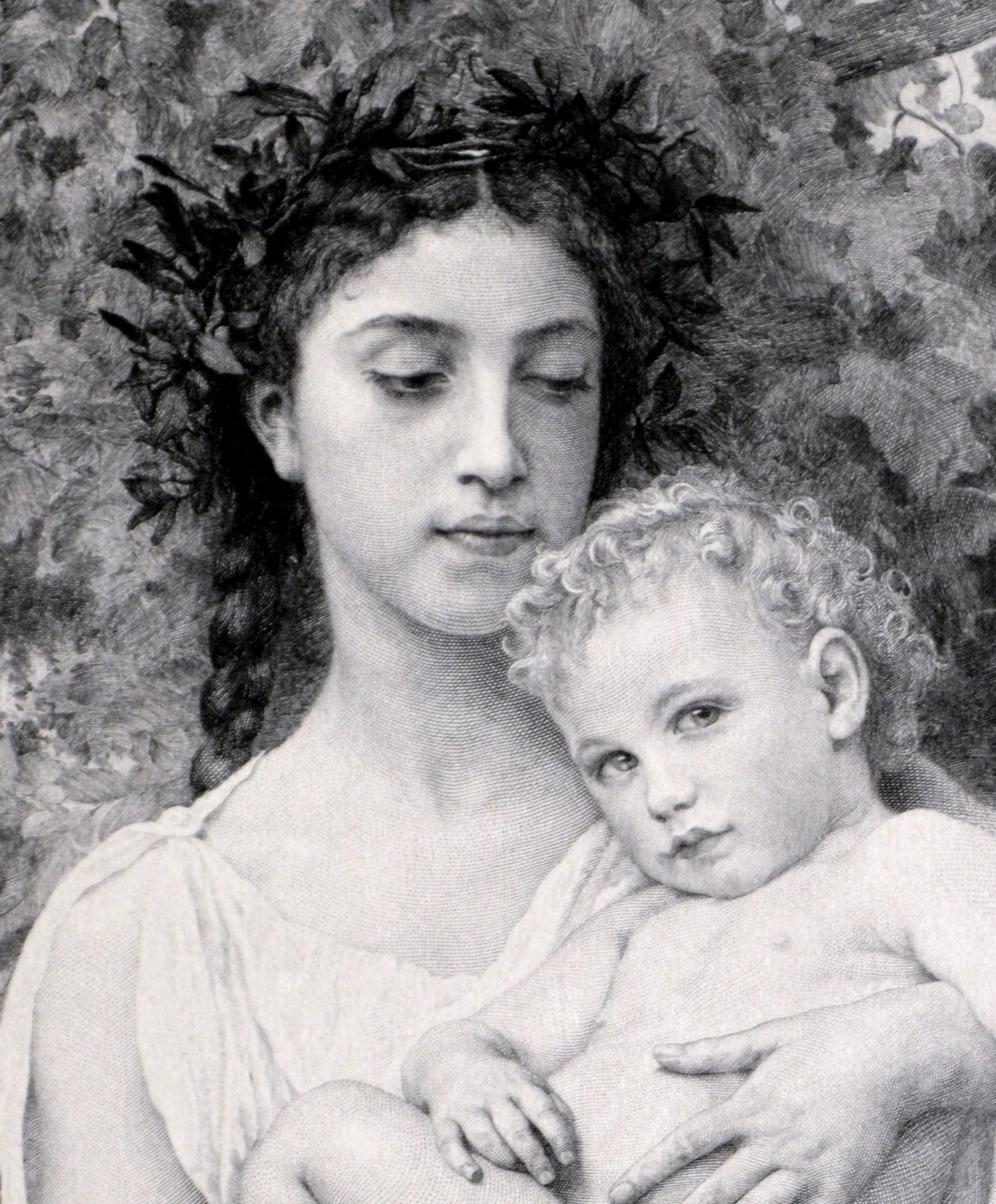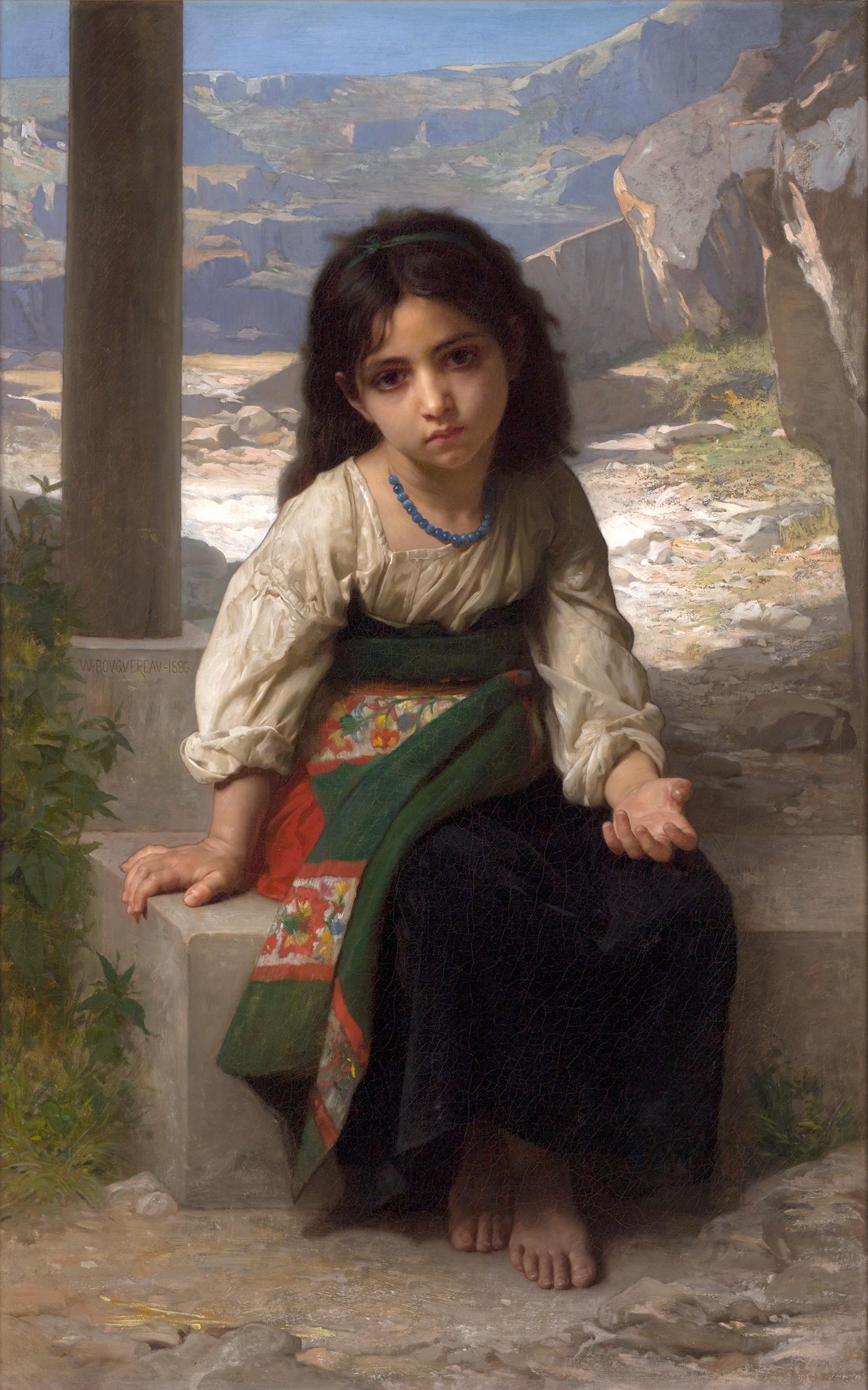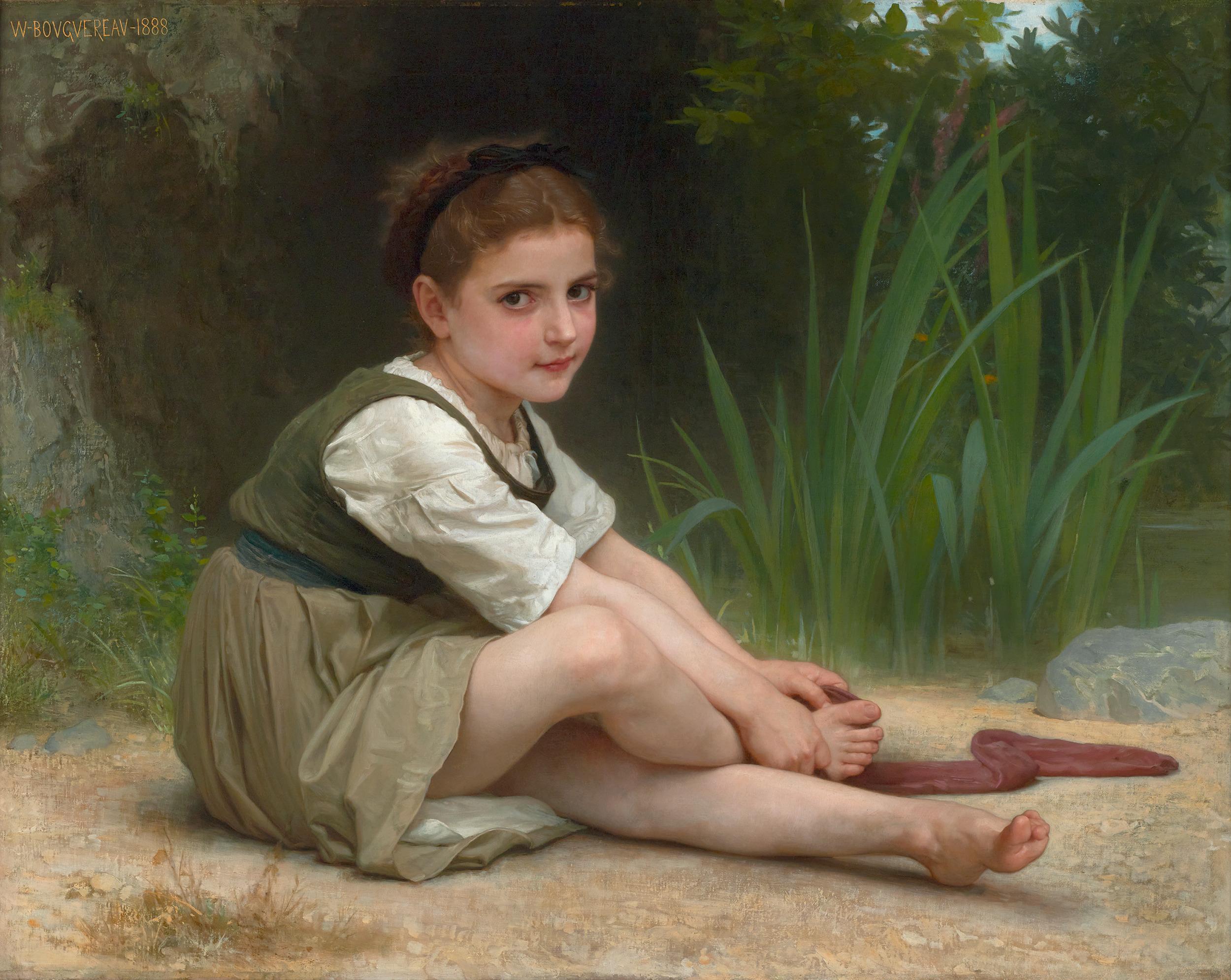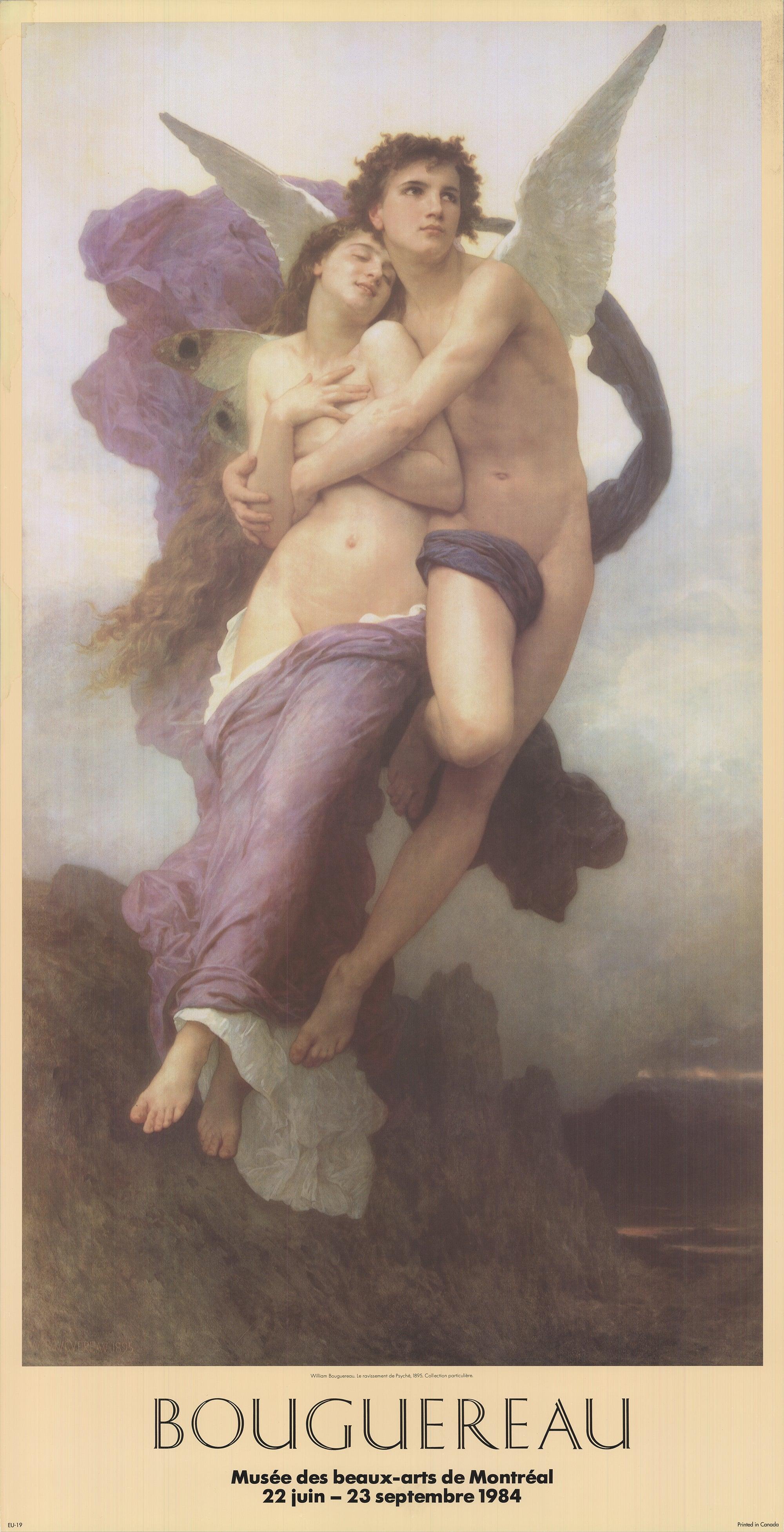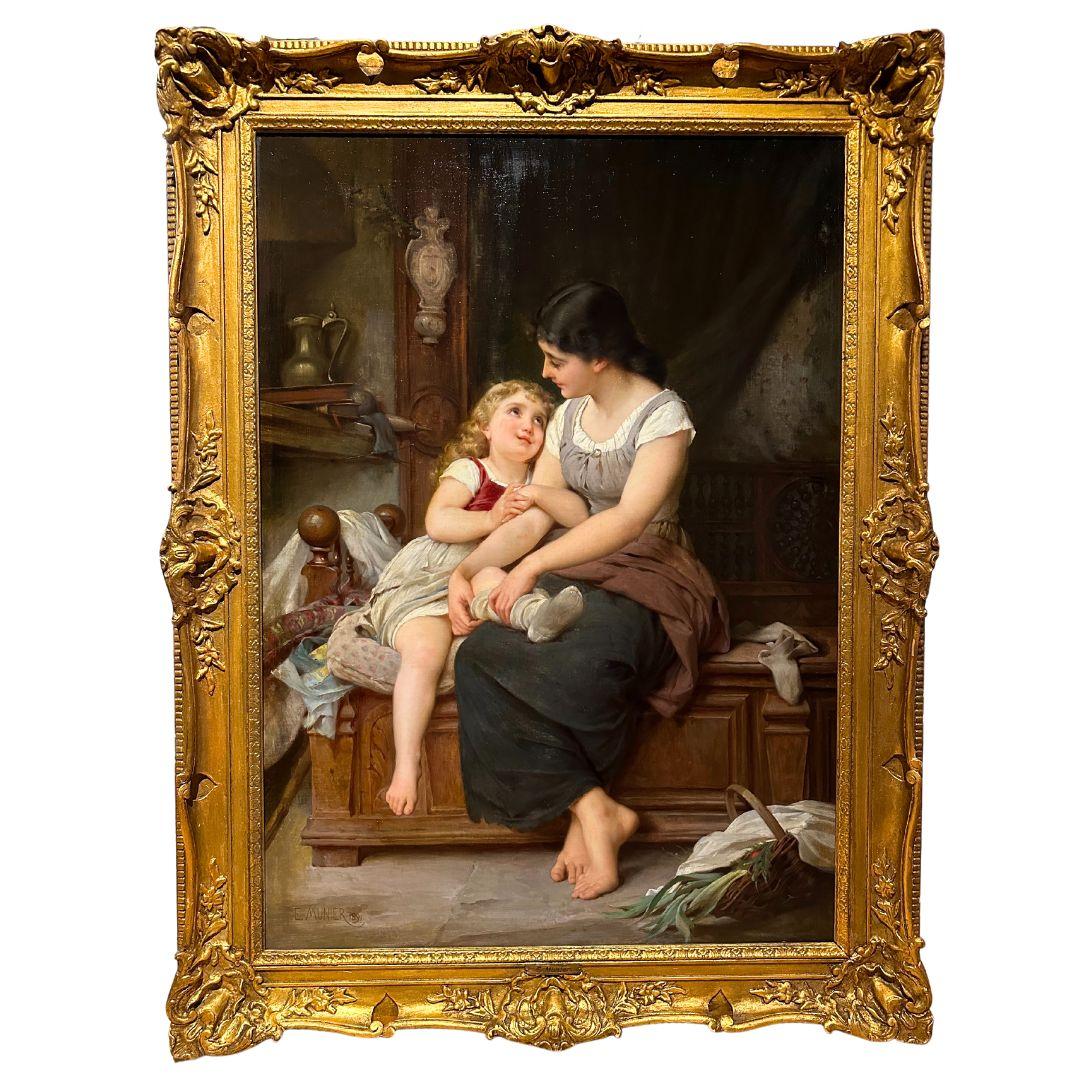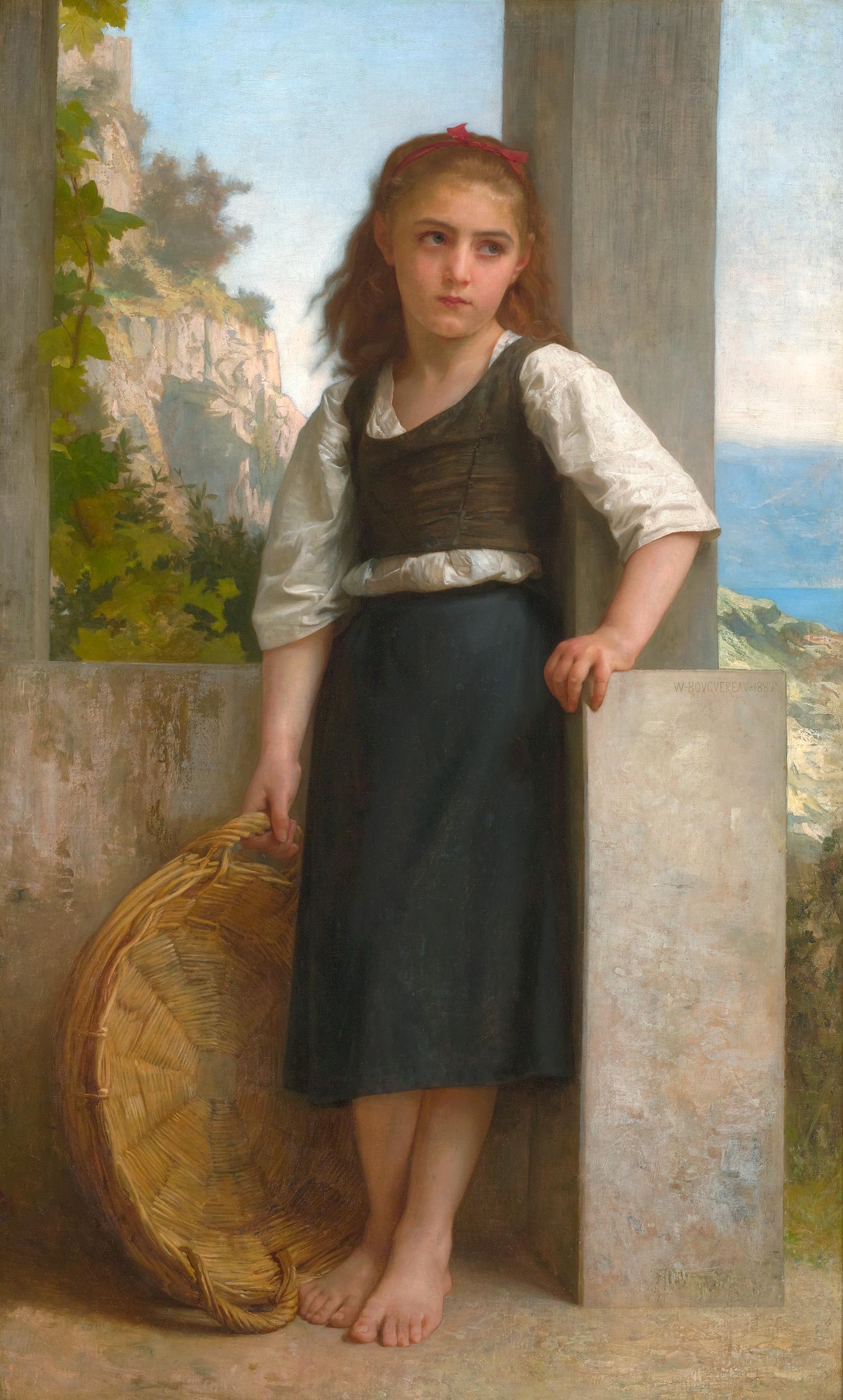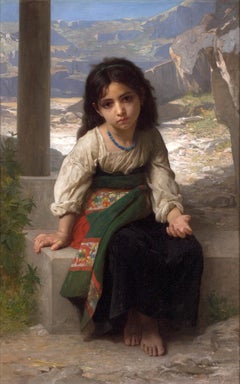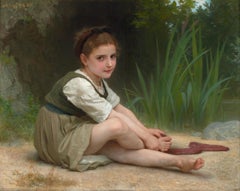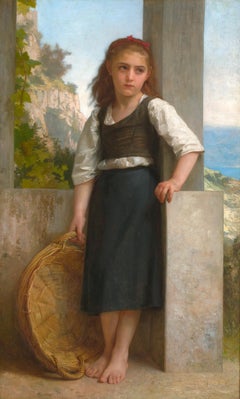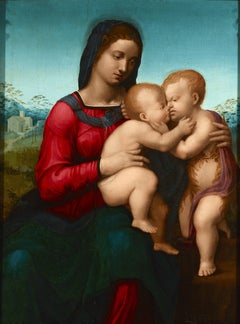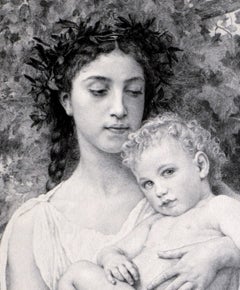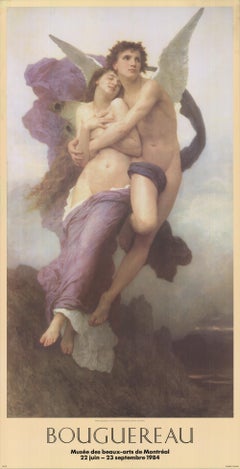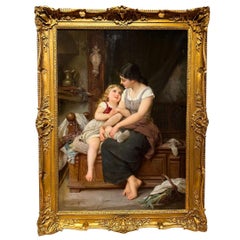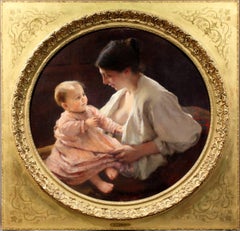Items Similar to Young Mother Contemplating Two Embracing Children by William-Adolphe Bouguereau
Want more images or videos?
Request additional images or videos from the seller
1 of 8
William-Adolphe BouguereauYoung Mother Contemplating Two Embracing Children by William-Adolphe Bouguereau1861
1861
$1,650,000
£1,250,187.94
€1,434,491.59
CA$2,321,816.31
A$2,552,314.94
CHF 1,341,379.61
MX$30,994,398.96
NOK 16,733,373.92
SEK 15,853,695.07
DKK 10,705,973.65
About the Item
William-Adolphe Bouguereau
1825-1905 French
Jeune mère contemplant deux enfants qui s'embrassent
(Young Mother Contemplating Two Embracing Children)
Signed “W-Bouguereau” (bottom right, 1861 date now obliterated)
Oil on canvas
William Bouguereau's influence on 19th-century art is profound, earning him a cherished place in the French Academy. His frequent exhibitions at the Paris Salon led to the event being colloquially known as “Le Salon Bouguereau.” Young Mother Contemplating Two Embracing Children stands out as an extraordinary work among his oeuvre, epitomizing the pastoral ideal and the classical grandeur inherent in Bouguereau’s oeuvre.
Bouguereau’s unparalleled ability to depict the moods and personalities of his subjects within classical settings is evident in this work. Influenced by the great Neoclassical artist Ingres, Bouguereau’s technique demonstrates an exceptional degree of finish and luminous coloration, characteristics of his prestigious education at the École Royale des Beaux-Arts. His portraits, especially those of young women and cherubs in idyllic natural settings, are among his most cherished works, with this being a particularly exquisite example.
In this composition, a classical beauty lounges in a mossy grove accompanied by her twin children, one fair and the other dark. Bouguereau displays his extraordinary mastery of dramatic lighting, with the mother cast in a cool shadow beneath the trees while the cherubs shine under a bright light in the foreground. The intricate rendering of the fabrics and the radiant skin of the figures imbues the scene with a luminous vitality that seems to leap off the canvas.
The classical ideal and the wonderment of a childhood spent in nature are themes celebrated across Bouguereau's oeuvre, making him an exceptional commercial success in his day. Collectors on both sides of the Atlantic had to wait two to three years to purchase one of his prized paintings. In the 19th century, no American collection would have been complete without a portrait by the French Academic master. Today, his works reside in prestigious museum collections such as the Musée d'Orsay, the Metropolitan Museum of Art and the J. Paul Getty Museum. Young Mother Contemplating Two Embracing Children is included in the Bouguereau catalogue raisonné as 1861/03.
Dated 1861
Canvas: 32 1/4” high x 39 3/4” wide (81.92 x 100.97 cm)
Framed: 49 3/8” high x 57” wide x 6“ deep (125.41 x 144.78 x 15.24 cm)
Provenance:
Sold by the artist to Paul Durand-Ruel
Private Collection of John. T. Martin, New York, before 1909
Martin Estate sale by American Art Association of New York, 1909, lot 40 (no illustration, listed as The Twins
C. K. G. Billings, New York, purchased from the above
Beverly Wilshire Hotel, Beverly Hills, CA
Private Collection of Jozeph Szymanski, Pasadena, CA, from 1971
Sale, Sotheby's New York, Nov. 3 1999, catalogue no. 7373, lot no. 55
Private Collection
M.S. Rau, New Orleans
Literature:
Galerie Durand-Ruel stock books
Charles Vendryès, Catalogue illustré des œuvres de W. Bouguereau, Librairie d'Art, Paris, 1885, p. 21
Amable Charles Franquet de Franqueville, "William Bouguereau" in Le Premier Siècle de l'Institut de France, Vol. I, J. Rothschild, Paris, 1895, p. 370 as Jeune mère contemplant enfants
Marius Vachon, W. Bouguereau, A. Lahure, Paris, 1900, p. 147
Mark Steven Walker, "A Summary Catalogue of the Paintings," in William Adolphe Bouguereau: L'art Pompier, New York, 1991, p. 66
Damien Bartoli and Frederick C. Ross, William Bouguereau: Catalogue Raisonné of his Painted Work, New York, 2010, p. 67, no. 1861/03 (illustrated
- Creator:William-Adolphe Bouguereau (1825 - 1905, French)
- Creation Year:1861
- Dimensions:Height: 49.38 in (125.43 cm)Width: 57 in (144.78 cm)Depth: 6 in (15.24 cm)
- Medium:
- Movement & Style:
- Period:
- Condition:
- Gallery Location:New Orleans, LA
- Reference Number:Seller: 31-96111stDibs: LU18615032052
About the Seller
5.0
Vetted Professional Seller
Every seller passes strict standards for authenticity and reliability
Established in 1912
1stDibs seller since 2013
19 sales on 1stDibs
Typical response time: 10 hours
- ShippingRetrieving quote...Shipping from: New Orleans, LA
- Return Policy
Authenticity Guarantee
In the unlikely event there’s an issue with an item’s authenticity, contact us within 1 year for a full refund. DetailsMoney-Back Guarantee
If your item is not as described, is damaged in transit, or does not arrive, contact us within 7 days for a full refund. Details24-Hour Cancellation
You have a 24-hour grace period in which to reconsider your purchase, with no questions asked.Vetted Professional Sellers
Our world-class sellers must adhere to strict standards for service and quality, maintaining the integrity of our listings.Price-Match Guarantee
If you find that a seller listed the same item for a lower price elsewhere, we’ll match it.Trusted Global Delivery
Our best-in-class carrier network provides specialized shipping options worldwide, including custom delivery.More From This Seller
View AllPetite Mendiante By William-Adolphe Bouguereau
Located in New Orleans, LA
William Bouguereau
French 1825-1905
Petite Mendiante
(Little Beggar)
Signed “W. Bouguereau 1880” (center left)
Oil on canvas
William Bouguereau's faithful images of young women a...
Category
19th Century Academic Figurative Paintings
Materials
Canvas, Oil
Au Bord Du Ruisseau By William-Adolphe Bouguereau
By William-Adolphe Bouguereau
Located in New Orleans, LA
William-Adolphe Bouguereau
1825-1905 French
Au Bord du Ruisseau
Signed and dated “W-Bouguereau-1888” (upper left)
Oil on Canvas
“Bouguereau’s paintings of children allowed for th...
Category
19th Century Academic Figurative Paintings
Materials
Canvas, Oil
La Fille Du Pêcheur By William Bouguereau
By William-Adolphe Bouguereau
Located in New Orleans, LA
William-Adolphe Bouguereau
1825-1905 French
La fille du pêcheur
(The Fisherman’s Daughter)
Signed and dated “W-Bouguereau-1882” (middle right)
Oil on canvas
William Bouguereau's...
Category
19th Century Academic Figurative Paintings
Materials
Canvas, Oil
Virgin and Child with the Infant Saint John
By Domenico Puligo
Located in New Orleans, LA
A masterful example of Italian Mannerist painting, this exceptional panel was composed by the renowned Florentine painter Domenico Puligo. Alongside Jacopo Pontormo and Rosso Fiorentino, Puligo is remembered as one of the foremost figures of the Mannerist movement that rose to prominence during the 16th century in Florence. This panel of the Virgin Mary with the Christ child and Saint John the Baptist is a characteristic example of his celebrated devotional images, which grace museums such as the Metropolitan Museum of Art (New York), Museo del Prado (Madrid), Palazzo Borghese (Rome), and Palazzo Pitti (Florence), among many others.
Puligo’s skill with color is fully demonstrated in the beautifully preserved work. Considering its age, the vibrancy and the sheer range of color is remarkable. The Virgin Mary’s crimson dress...
Category
16th Century Mannerist Portrait Paintings
Materials
Oil, Panel
Solitude
By Guillaume Seignac
Located in New Orleans, LA
French Academic painter Guillaume Seignac was renowned for his masterful treatment of the idealized nude. His languishing female subjects based on Greco-Roman prototypes were and rem...
Category
19th Century Academic Nude Paintings
Materials
Canvas, Oil
Solitude
By Guillaume Seignac
Located in New Orleans, LA
Signed “G-Seignac” (lower right)
Oil on canvas
French Academic painter Guillaume Seignac was renowned for his masterful treatment of the idealized nude. His languishing female subje...
Category
19th Century Academic Nude Paintings
Materials
Canvas, Oil
You May Also Like
Julien Deturck (1862-1941) "The Young Brother" after William Bouguereau 1901
By William-Adolphe Bouguereau
Located in Argenteuil, IDF
Beautiful etching on wove paper with a watermark, BFK Rives, signed, titled, and published by the Société Française des Amis des Arts around 1900.
Title
"Le jeune frère"
engraved by
...
Category
Antique Early 1900s French Romantic Prints
Materials
Paper
William-Adolphe Bouguereau 'The Seduction of Psyche' Vintage
By William-Adolphe Bouguereau
Located in Brooklyn, NY
This high-quality reproduction of "The Seduction of Psyche" by William-Adolphe Bouguereau, published in 1999 by the Montreal Museum of Fine Arts, captures the delicate beauty and ref...
Category
1990s Romantic Prints and Multiples
Materials
Offset
"Mom in Love" 19th Century Academic Realistic French Oil Painting on Canvas
By Emile Munier
Located in Jacksonville, FL
Émile Munier, a French academic artist born in 1840, was renowned for his exquisite depictions of children and domestic scenes during the late 19th century. "Mom in Love," a masterpi...
Category
19th Century Realist Figurative Paintings
Materials
Oil
"Mother and Child" Important 19th Century Oil Painting
By Paul Alexandre Alfred Leroy
Located in New York, NY
A wonderful depiction of mother and child displayed in a gold round ornate frame with intricate details.
Category
Late 19th Century Realist Figurative Paintings
Materials
Oil, Canvas
After William-Adolphe Bouguereau - Framed 20th Century Oil, L'Amour et Psyche
Located in Corsham, GB
A later copy of William-Adolphe Bouguereau 1890's classical painting L'Amour et Psyche, enfants. Unsigned. Presented in an elegant antique gilt slip. H...
Category
20th Century Figurative Paintings
Materials
Oil
A Fine and Charming 19th Century Victorian Oil on Canvas "Mother and Child"
Located in LA, CA
Attributed to Charles Edward Hallé (British, 1846-1914) "Mother and Child" oil on canvas. The Victorian era artwork depicting a young mother holding her joyful infant child, within a...
Category
Late 19th Century Portrait Paintings
Materials
Oil
More Ways To Browse
19th Century Oil Portraits Of Children
1900s Oil On Canvas Portrait
Florence White Paintings
Gustav Likan
Kadar Bela
Mandolin Painting
Medusa Painting
Oil Painting Of Soldier
Oil Paintings Of Ballerinas
Roger Fry
Scottie Wilson
Vintage Girl Reading
Vladimir Dimitrov
Airplane Paintings
Anna Mary Robertson
Architectural Relief Sculpture
Breast Painting
Devil Oil Painting
